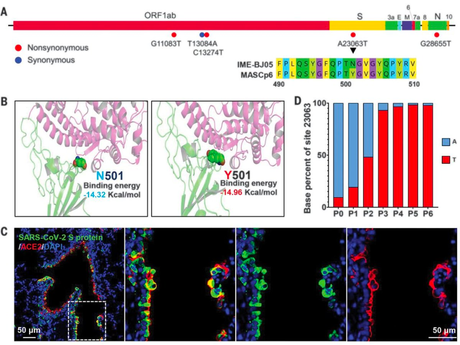A recent FOIA request by Right To Know’s Emily Kopp yielded new information about Project Defuse, a DARPA grant proposal from 2018 to study bat-borne Coronaviruses that included Wuhan Institute of Virology researcher Shi Zhengli.
The newly released documents, show collaborators’ internal notes on drafts of the grant proposal, which yielded two small revelations:
- The grant proposal tried to downplay the involvement of the Chinese collaborators doing bioengineering work, because the scientists thought DARPA would be less likely to fund the project if they thought that work was occurring in China.

Some had previously dismissed Project Defuse as irrelevant, because these bioengineering experiments were proposed to be done at Ralph Baric’s lab at UNC, and it was claimed that Shi’s lab didn’t have the expertise or equipment to preform these sorts of experiment, but the grant shows Shi’s lab has the capabilities and interest. - The language originally listed work that could be performed at BSL-2 to save money compared to other viral models.

This is important because it shows that scientists involved in writing this grant thought that it was indeed appropriate to perform these risky experiments at low biosafety levels. And because these experiments would not be performed at BSL-2 in American labs, it adds evidence to the idea that despite what was written in the final grant proposal, the team was planning to do these experiments in China.
I was curious how people were reacting to these revelations and the state of the covid origin debate since I hadn’t checked in for a while, and I came across the rootclaim covid origins debate. It’s a long watch, and I learned a little, but it was disappointingly low quality.
The debate into Covid origins online has been poisoned by tribalism and conspiracy theorists, and I was hoping this debate would be a forum, where debaters could actually present and discuss the best arguments for Covid’s most likely origin.
At the beginning they make a disclaimer about how they aren’t subject matter experts, but with an issue like the origin of covid that needs to incorporate and evaluate multiple factors like biology, politics, statistics, epidemiology — what really matters is your approach. Sure, I’m on board so far. But man were they not subject matter experts — both debaters showed little understanding of biology and how wet lab research works.
On the Zoonotic side, Peter Miller seems terminal online and imagines himself a crusader against Steve Bannon and scientific misinformation, while spreading misinfo himself. He spent a lot of time straw-manning conspiracy theorists who promote the lab leak — yes many conspiracy theorists promote the lab leak (gasp) — but that has zero impact on Covid’s origin.
On the lab leak side, Saar Wilf, wanted to hawk his “probabilistic inference” system and then got super hung up on a pet theory about a Majong Room. And because he has no experience with biology or much interest in the lab leak theory in general, he didn’t even attempt to challenge Peter’s bogus claims. I guess that was the role of Yuri Deigin in the 2nd debate, who *checks notes* is a former programer who works on the business side in biotech?
Most of the debate consisted of Peter Miller confidently asserting things — which sometimes made sense and seemed on point — but just as often and just as confidently, he’d assert things that were completely factually incorrect.
For example, at 1:02:50 in the second debate, Miller claims that Sars Cov 2 could not have leaked from animal passaging experiments in humanized mice because it always acquires a mutation to its spike, N501Y.
To support this he shows this figure, without any context:

The first sign that something’s off, is that Peter doesn’t provide a citation or a figure caption. Weird, well, okay — I had to try a couple google searches before I found the article this figure is from because even just based on the title, it’s so obviously different from how Peter described it: Adaptation of SARS-CoV-2 in BALB/c mice for testing vaccine efficacy.
It’s not a paper passaging SARS-CoV-2 in humanized mice, it’s a paper passaging SARS-CoV-2 in wildtype mice to create a new strain of SARS-CoV-2 that infects wildtype mice as an experimental model.
The ongoing coronavirus disease 2019 (COVID-19) pandemic has prioritized the development of small-animal models for severe acute respiratory syndrome coronavirus 2 (SARS-CoV-2). We adapted a clinical isolate of SARS-CoV-2 by serial passaging in the respiratory tract of aged BALB/c mice. The resulting mouse-adapted strain at passage 6 (called MASCp6) showed increased infectivity in mouse lung and led to interstitial pneumonia and inflammatory responses in both young and aged mice after intranasal inoculation. Deep sequencing revealed a panel of adaptive mutations potentially associated with the increased virulence. In particular, the N501Y mutation is located at the receptor binding domain (RBD) of the spike protein. The protective efficacy of a recombinant RBD vaccine candidate was validated by using this model. Thus, this mouse-adapted strain and associated challenge model should be of value in evaluating vaccines and antivirals against SARS-CoV-2.
To their credit, in the following debate judges pushed him on his claim, asking him does this N501Y mutation always emerge when passaging SARS-CoV-2 in humanized mice — or was it just one study. Multiple studies Miller claimed, making his confusion harder to justify. I get making this mistake once, but now it sounds like you’re just skimming papers, guessing what they’re saying, and getting it very wrong.
And this isn’t a trivial issue, we know from the Defuse grant proposal that Shi Zengli’s lab has humanized mice (transgenic mice that express human Ace2 receptor) — And as mentioned in proposal, we know they were interested in isolating samples with novel SARSr-CoV, and that they have previously tested strains in humanized mice: “we have shown evidence of recent spillover of SARSr-CoVs into people in China, and have isolated strains capable of producing SARS-like illness in humanized mice.”
All it takes to leak SARS-CoV-2-like virus in the wild, giving it to a humanized mouse, and a lab tech breathing air in the mouse facility or any one of things off of the assumption that it isn’t a highly-transmissible airborne disease (as they were clearly assuming by their proposal to do these experiments in BSL-2).
So you’re back to the original debate of the two coincidences. Is it a bigger coincidence that the first known superspreader event occurred at a wet market with wild animals, or is the bigger coincidence that SARS-CoV-2 emerged in the same city as the lab that had collected what was at that time SARS-CoV-2’s most closely-related genetic sample, had written a proposal a couple years earlier to collect and chararcterize new SARS-related coronaviruses.
Neither side has a smoking gun and probably never will. The decision to cull possible animal reservoirs, and then delays in testing the Huanan Seafood Market may have made it impossible to find the truly killer evidence in support of zoonosis. But China’s lack of transparency, repressive government and hostility towards investigative journalism make it difficult to know to what extent our picture of the early cases is accurate, and to determine whether the seafood market was the site of the spillover or whether it was an early super-spreading event.
In some ways Covid’s origin is an important question: if it was a zoonotic spillover at the Huanan Seafood Market, then we need more research into these rare emergent diseases, and we need to shut down exotic animal markets around the world. If it was a lab leak, we need higher levels of biosafety and we need to consider the risk-benefit of researching these diseases more carefully, and we probably shouldn’t be doing research on unknown and risky diseases in one of the biggest population centers in the world.
But the true answer is we need both. We need to take zoonosis more seriously, and we need more research into the diseases that could cause the next pandemic, but we need to take biosafety as seriously as we take nuclear security. And that doesn’t just mean strictly vetting grants and conducting research at higher bio-safety levels, but designing systems that carefully track and log the movement of infectious agents, with strong safeguards in place to protect both from accidental release or intentional release by bad actors.
In 2001, a mentally ill American scientist working on an Anthrax vaccine was going to be moved to another project. But he really believed in his vaccine, that Saddam Hussein had anthrax bioweapons, and he was very mentally ill, so he sent letters with anthrax to the media and Congress. And, at first, his plan “worked” in that there was a lot of renewed interest in Anthrax and his anthrax vaccine.
We know this now because of the tight security we keep around anthrax — transfer between labs were recorded, the amount used from every vial was tracked, key cards in and out of storage rooms were logged.
The pandemic has shown us that a novel pathogen can be orders of magnitude more deadly than highly restricted pathogens like anthrax, and orders of magnitude deadlier than atom bombs.
We shouldn’t just trust that people to handle these sorts of diseases properly. We don’t do it with anthrax and we don’t do it with nuclear weapons.
We should could create a world where we don’t have to debate a lab leak because any lab studying a disease like covid is regulated and documented by an international body that would leave us zero doubt about what they were studying, when, and why.

